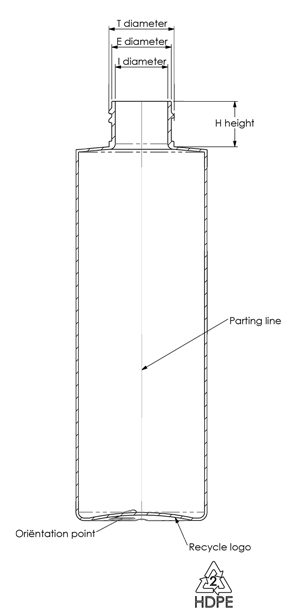
HDPE bottles
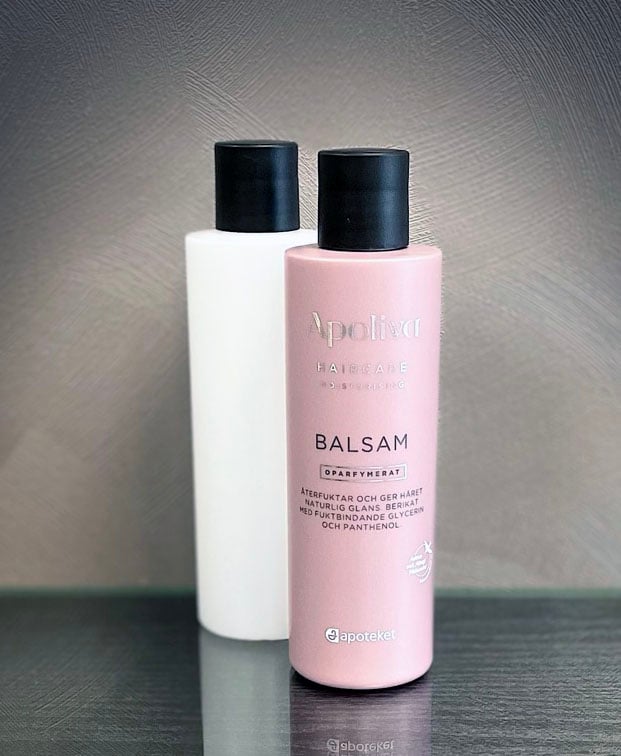
HDPE bottles on Stock
Frapak has been supplying HDPE bottles for over 30 years. We use our experience to provide a wide range of standard HDPE bottles. We are also producing PET bottles. Our plastic HDPE bottles are produced in Europe to ensure the highest quality plastic packaging.
HDPE bottle manufacturer
The successful series like the Boston Round, Disc Round, Square, Oval, and several Trigger bottles are available in different sizes and in many standard neck finishes. If you are looking for low minimum order quantity (MOQ) check our wide assortment and stocks.
HDPE bottle supplier for over 30 years
If a standard bottle is not exactly what you are looking for we can offer custom moulding design bottles on orders from 150,000 units per year. All the custom designs are made by 3D software programs like Solidworks which allows us to create custom designs at low cost. 3D prototypes can also be easily made in house as Frapak uses rapid prototyping.
Frapak Packaging supplies HDPE bottles in different styles and has many articles on stock.
For our HDPE bottles we have added a few items on our stock and even in rHDPE. The stock Items of our HDPE bottle assortment is starting from 50ml till 1000ml.
Extrusion blow moulding of HDPE bottles
The extrusion blow moulding (EBM) process is known for its flexibility in materials as well as product design. The most common materials used for blow moulding are HDPE, LDPE and also polypropylene or PP. Different materials are also used like PVC, PET bottles and other thermoplastic materials.
In the blow moulding process the raw material, in granulate or powder form, is fed into the blow moulding machine. By means of a rotating screw and a heated barrel, the thermoplastic material is warmed up. At the end of the extruder the heated plastic is formed into a parison by the extruder head.
This parison which is a hollow tube is then caught by the blow mould and blown against the cooled walls of its sides and formed into a bottle. In the last station the excess of the material is removed from both the neck and bottom.
The blow moulds used by Frapak Packaging vary in size from 5 ml up to 1 litre and can consist of one single cavity, to moulds with more than 8 cavities. The number of cavities increases the output per production hour but decreases the flexibility of colour or neck changes.
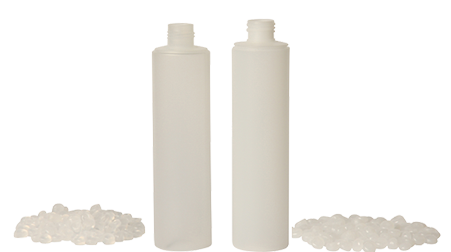
What are HDPE bottles?
The raw material of HDPE bottles is HDPE which is an acronym of High Density Poly Ethylene. This raw material is a thermoplastic and has the recycling code 2. As HDPE bottles or PEHD bottles has a high tensile strength it is very suitable for the blow moulding of cosmetic bottles.
LDPE or PELD has a lower density and therefore less tensile strength making it softer. In some cases both PE materials are mixed together so that the bottles are strong enough but can still be squeezed.
HDPE bottles advantages
The advantages of blow moulding is that the process is very flexible in regard to the raw materials which can be used and allows more freedom in design. Extreme designs can be achieved such as off centre neck placements and openings, even a punched hole is possible
The other advantage is that the weight and the wall thickness can be controlled using the PLC of the blow moulding machine which enables the same bottle to be produced in different weights.
Although mono layer bottles are adequate in most cases, sometimes it is necessary to have more than one layer in your bottle; this is called multi-layer. By adding co-extruders to the blow moulding machine it is possible to create multi-layer bottles.
These extra layers provide a better chemical resistance (garden care/care care), a barrier against UV or a soft touch finish commonly found in the cosmetic market.
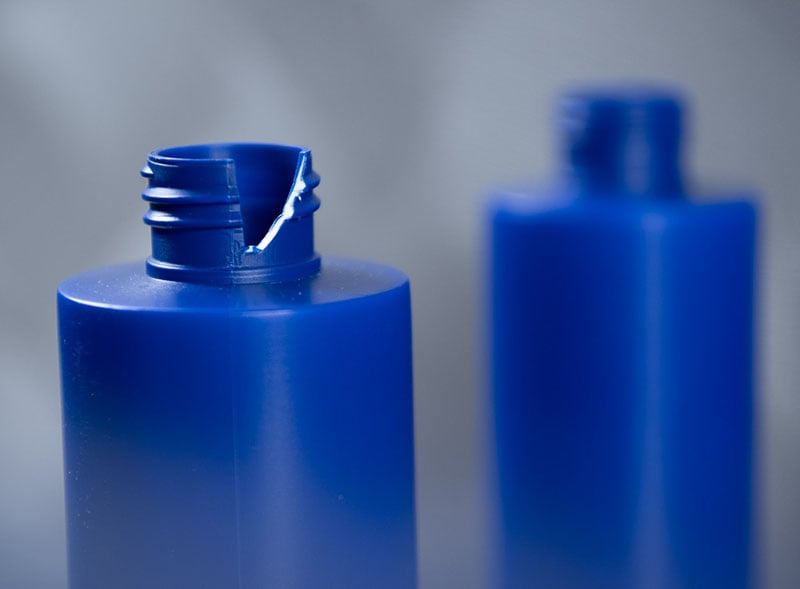
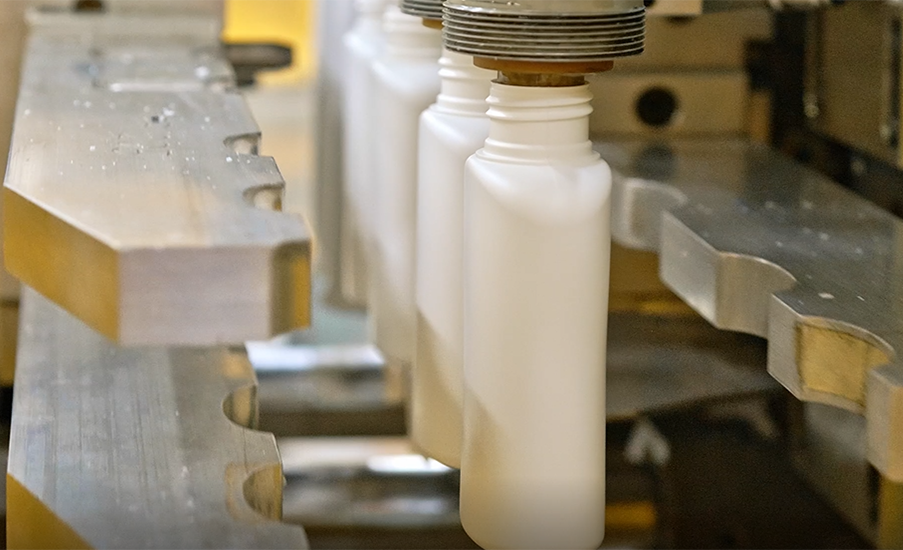
The features of HDPE bottles
- Mechanical properties such as high tensile strength, less stiffness and elongation
- Low water vapour and aroma permeability
- Good grease resistance
- Good heat resistance up to 130 degrees
- Not transparent
Although the HDPE bottle looks quite simple, it has quite a lot of components and aspects which have to be taken care of:
The neck part is one of the most important features of the bottle as it’s here that the closure is positioned; it is therefore critical to ensure a good fit and avoid leakage. The closure can either be a snap fit, which is common for shampoo bottles or be screwed on the different GCMI standard neck finishes like 20-410, 24-410 and 28-410.
In this industry norm there are strict specifications on the T and E diameter so caps and pumps with the same standard always fit. If the closure features a plug seal, the inner diameter of the neck needs to be calibrated so that there is a smooth and even finish to the inside of the bottle neck.
The H-dimension of the SPI or GCMI norm determines the height of the neck of the HDPE bottles. Some of our customers prefer a higher closure, more elegant packaging and therefore our HDPE are also available with a 20-415 or a 24-415 Neck.
The design of the HDPE bottles
The design of the shoulder of the HDPE bottle can have an impact on the top load resistance, this means that the mechanical strength of the bottle is partly determined by its design. In cases where a high top load is expected because of the application of a snap closure or because of the stackable weight in the logistic chain, then some precautions should be taken.
Body of the HDPE bottle
The body of the PE bottle normally accommodates the label, although this does depend on its design. It is, therefore, technically important for this surface to be as flat as possible and have one single curvature so that the label can be easily applied.
With round HDPE bottles the parting line of the blow mould is covered by the label or by a screen print. This parting line should therefore be as smooth as possible. To enable the efficient filling of the HDPE bottles the design of the body has to be such that the bottle remains stable on the conveyor and does not nest.
The bottom of plastic HDPE bottles
The bottom of the bottle ensures this stability and usually accommodates the HDPE recycling logo, the cavity number and the article number. In most cases the producer adds his logo so that the origin of production can be identified. The bottom of a bottle also usually has an orientation point with a specific shape which allows the HDPE bottle to be screen printed.
This point makes the positioning of the screen print easier and can therefore be positioned is such a way that the front of the design is aligned with opening of the closure on the bottle.
